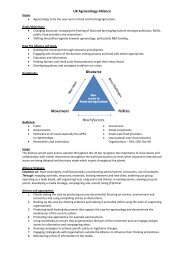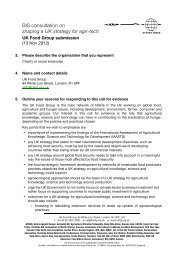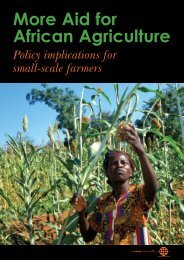Common Agricultural Policy - UK Food Group
Common Agricultural Policy - UK Food Group
Common Agricultural Policy - UK Food Group
Create successful ePaper yourself
Turn your PDF publications into a flip-book with our unique Google optimized e-Paper software.
The <strong>Common</strong> <strong>Agricultural</strong> <strong>Policy</strong> 30<br />
8. How does the CAP impact upon world prices?<br />
These impacts are variable, depending on the regimes<br />
examined and the scale of the EU’s presence in the world<br />
market. Heavily protected regimes which generate<br />
surpluses for export will tend to depress world market<br />
prices through the export subsidy system both in the short<br />
term and through their effects upon price expectations. The<br />
table below identifies those major temperate commodities<br />
where the EU has a share of more than 10 per cent of<br />
world trade, either in imports or exports (fig 3.3).<br />
The table shows the importance of the EU in a number of<br />
export markets, particularly for wine and livestock<br />
products. Generally the overall effect of the CAP will be to<br />
depress world price levels in these sectors because of the<br />
domestic support in place, reinforced by import tariffs and,<br />
in some sectors, by export subsidies as well. In the case of<br />
butter for example where EU internal prices are around<br />
double those on the world market, dumping by the EU will<br />
be a major factor in keeping world price levels low.<br />
However, where price differentials are much smaller, as they<br />
have been for wheat in recent years, the impact on world<br />
prices will be smaller. Even the less trade distorting<br />
elements of the CAP can have impacts on world prices.<br />
For example, the direct payments on cereals, beef,<br />
oilseeds, olives and sheepmeat will help to bolster the<br />
competitiveness of EU farmers and allow them to adapt to<br />
lower market prices than otherwise would be possible. The<br />
scales of such effects are difficult to measure.<br />
Various attempts have been made to determine the effects<br />
of the CAP on world prices. Some of these attempts have<br />
used economic modelling to predict what effect removal of<br />
market-distorting CAP measures would have and use these<br />
results to show how the CAP is currently influencing world<br />
economy. One such economic modelling study was<br />
undertaken by Borrell and Hubbard (Economic Affairs, June<br />
2000). They used the Global Trade Analysis Project (GTAP)<br />
database and standard economic model. In the model all<br />
EU barriers to trade and direct subsidies are eliminated,<br />
thus removing all CAP support to farmers and lowering the<br />
Source: European Commission 2001c<br />
fig 3.3<br />
Major Commodities for which the EU has more than 10 per cent of world trade (1997)<br />
EU Share of Trade<br />
Commodity<br />
(1)<br />
Imported<br />
(2)<br />
Exported<br />
(3)<br />
EU net<br />
by EU by EU share of<br />
world<br />
trade<br />
Cereals (except rice) (3.2) 10.2 (7.0)<br />
– of which wheat (3.5) 13.2 (9.5)<br />
Oilseeds 39.6 (1.8) -37.8<br />
– of which soya 39.4 (0.7) -39.3<br />
Wine 27.9 60.6 32.7<br />
Sugar (5.3) 18.8 13.5<br />
Total Milk (3.0) 28.0 25.0<br />
– of which butter 11.1 20.2 (9.1)<br />
– Cheese 11.6 40.8 29.2<br />
– Milk powder (2.9) 30.3 27.4<br />
Beef and veal (6.6) 19.1 12.5<br />
Pigmeat (3.0) 51.2 48.2<br />
Poultrymeat (3.7) 20.4 16.7<br />
Eggs (2.7) 29.5 26.8





